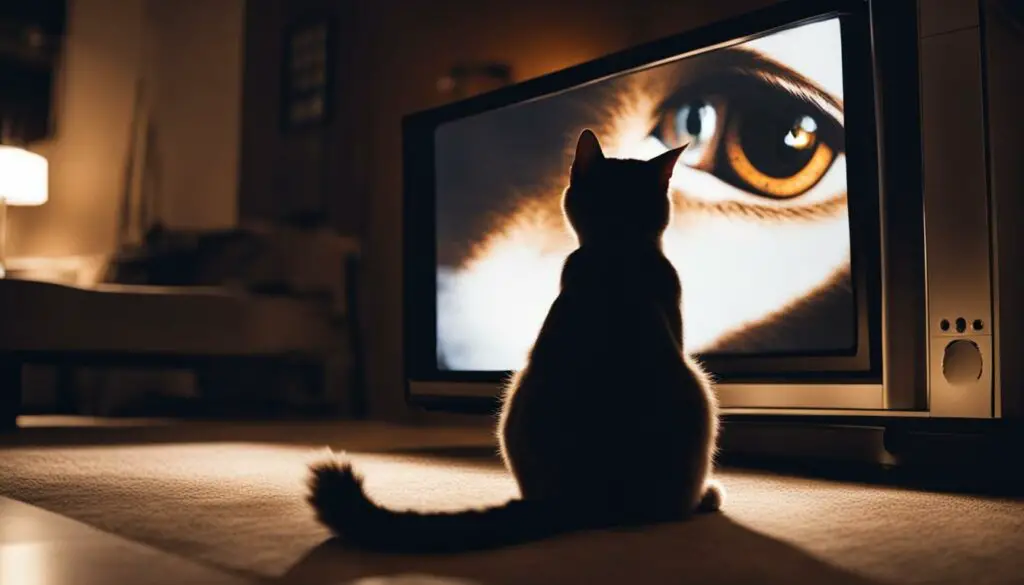Cats are fascinating creatures, and their behaviors can sometimes leave us puzzled. One common behavior that many cat owners wonder about is why their feline friend insists on sitting in front of the TV. As a cat behavior enthusiast, I’ve delved into this topic to shed some light on the reasons behind this intriguing behavior.
While there isn’t a one-size-fits-all answer, several factors could contribute to your cat’s fascination with the television. Cats are natural hunters, and the movement and sounds on the screen can trigger their prey instincts, captivating their attention. The bright colors and flickering images might also attract them, similar to how they are drawn to their toys. Additionally, the warmth emitted from the TV might provide a cozy spot for them to relax.
Curiosity is another factor that drives cats to sit in front of the TV. They are naturally inquisitive creatures, and the images and sounds coming from the screen might simply pique their interest. Cats enjoy watching movement and being a part of the action, which explains why they sometimes spend hours observing birds or squirrels outside a window.
It’s also worth considering that your cat’s TV fixation could be a way of seeking attention. Cats are social animals and crave interaction with their human companions. By sitting in front of the TV, they may be trying to engage with you and get your attention. Understanding this can help you find alternative sources of stimulation and play that fulfill their need for attention.
For some cats, sitting in front of the TV can provide comfort and alleviate separation anxiety. The presence of the TV and the sounds it emits can provide a sense of companionship, especially when their human family members are away. Providing them with other sources of comfort, such as a cozy bed or blankets with your scent, can help alleviate their stress and provide a sense of security.
Cats are visually oriented animals, and the visuals on the TV screen can provide them with entertainment and mental stimulation. The movement, colors, and sounds can capture their attention and keep them engaged. However, it is important to ensure they have a variety of other enrichment options available, such as interactive toys and scratching posts, to prevent boredom and unhealthy fixation on the TV.
While sitting in front of the TV might be normal behavior for cats, it can become problematic if it interferes with their daily routines or causes disruptions. In such cases, redirecting their attention and providing alternative sources of entertainment, like interactive toys and designated play areas, can help address the issue.
Creating a cat-friendly environment that meets their needs is crucial. Vertical spaces, such as cat trees or shelves, give them opportunities to climb and observe their surroundings. Also, incorporating scratching posts, hiding spots, and puzzle feeders can fulfill their natural instincts and prevent boredom.
Positive reinforcement and training can be effective in redirecting your cat’s attention away from the TV. Rewarding desirable behaviors, such as playing with their toys or using their scratching post, can discourage fixation on the TV. Consistency and patience are key when training your cat, and it may take time for them to break the habit of sitting in front of the TV.
Remember, every cat is unique, and it may take some time and experimentation to find the best approach for your furry friend. By understanding why your cat sits in front of the TV and providing appropriate alternatives and enrichment, you can ensure their needs are met while enjoying quality time together.
Key Takeaways:
- Cats sit in front of the TV for various reasons, including prey instincts, curiosity, seeking attention, and comfort.
- Understanding your cat’s fascination with the TV helps you provide appropriate stimulation and play options.
- Creating a cat-friendly environment with vertical spaces, scratching posts, and interactive toys can redirect their attention from the TV.
- Positive reinforcement and training can be effective in redirecting your cat’s focus away from the TV.
- Managing screen time and providing alternative entertainment options are important to prevent overstimulation and boredom.
Common Reasons for Cat’s TV Fixation
Cats sitting in front of the TV is a behavior that many cat owners find intriguing. But why do cats exhibit this behavior? Understanding the reasons behind their fascination with the television can help you better address your cat’s needs and provide appropriate stimulation. There are several common reasons why cats may sit in front of the TV.
Prey Instincts:
One possibility is that the movement and sounds on the screen capture their attention, triggering their prey instincts. Cats are natural hunters, and the rapid movements and sudden noises on the TV can mimic the behavior of prey. They may see the moving images as potential targets and are fascinated by the chance to “hunt” from the comfort of your living room.
Visual Stimulation:
Another reason for cat’s interest in the TV is the bright colors and flickering images. Cats are attracted to visually stimulating objects, and the colors and movement on the screen can be highly alluring to them. It’s similar to how they might be drawn to a toy with vibrant colors or a laser pointer’s red dot.
Cozy Spot:
In addition to the visual appeal, sitting in front of the TV can provide a warm and cozy spot for cats. The warmth emitted from the television can be comforting and enticing to them. It’s like having a personal sunbeam that they can curl up in, making it an appealing place to relax and observe their surroundings.
Table: Reasons for Cat’s TV Fixation
| Reasons | Description |
|---|---|
| Prey Instincts | The movement and sounds on the screen trigger their natural hunting instincts |
| Visual Stimulation | Bright colors and flickering images on the screen are visually captivating for cats |
| Cozy Spot | The warmth emitted from the TV provides a comfortable and warm place for cats to relax |
Understanding these common reasons for cat’s TV fixation can help you address their needs and provide alternative outlets for their prey instincts and visual stimulation. By engaging your cat in interactive play sessions, providing stimulating toys, and creating a cozy and enriching environment, you can ensure they have a fulfilling and satisfying experience beyond the TV screen.
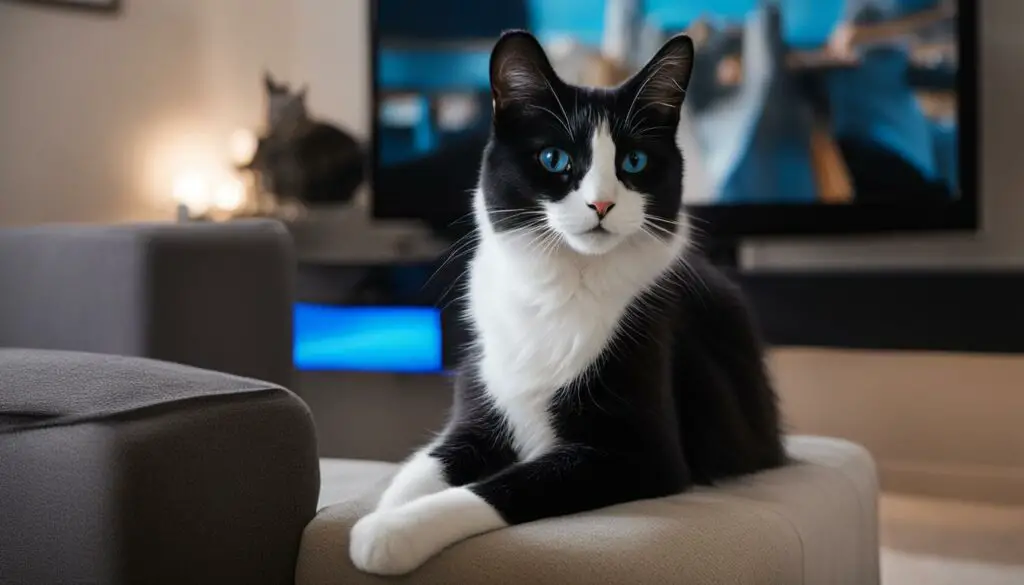
Next, we will explore other factors that can contribute to a cat’s interest in the TV, such as curiosity and attention-seeking behaviors. By gaining a deeper understanding of these behaviors, you can better manage your cat’s TV fixation and ensure their overall well-being.
Curiosity and Observation
When it comes to understanding why your cat sits in front of the TV, curiosity and observation play a significant role. Cats are naturally curious creatures and love to explore their surroundings. When they see movement and hear sounds coming from the TV screen, it piques their interest. They may find it fascinating to watch the images and be a part of the action happening on the screen. It’s similar to how they observe birds or squirrels outside a window. So, if your furry friend sits in front of the TV, it’s likely their way of satisfying their curiosity and engaging with their environment.
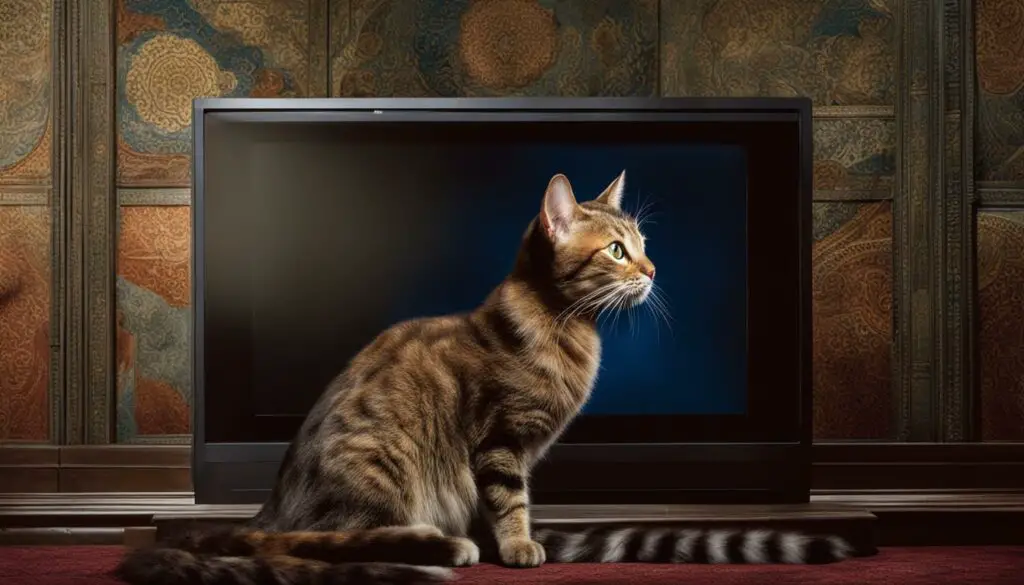
But why are cats so curious about the TV? One reason could be the rapid movements and sudden noises on the screen. As natural hunters, cats are instinctively drawn to the behavior of prey. The movement and sounds on the TV mimic the characteristics of prey, triggering their hunting instincts. Additionally, the bright colors and flickering images on the screen can attract cats, just like how they are attracted to their toys. It provides them with visual stimulation and entertainment, keeping them engaged and entertained.
To cater to your cat’s curiosity, it’s essential to provide alternative outlets for their energy and stimulation. Interactive toys, puzzle feeders, and scratching posts can keep them mentally and physically engaged. You can also create a designated play area where they can explore and interact with their toys. By satisfying their need for curiosity and observation, you can ensure that your cat’s TV-watching behavior is redirected towards more appropriate activities.
Redirecting Your Cat’s Attention from the TV
If your cat has developed a fixation with the TV, there are several strategies you can employ to redirect their attention and provide them with alternative sources of stimulation. Here are some tips on how to redirect your cat’s attention from the TV:
Create Interactive Play Sessions:
Engaging in interactive play sessions with your cat can help redirect their focus away from the TV. Use toys that mimic prey, such as feather wands or interactive laser pointers, to satisfy their hunting instincts. By providing them with an opportunity to engage in playtime with you, you can provide mental and physical stimulation that is more fulfilling than simply watching the TV.
Provide Puzzle Toys:
Puzzle toys can be a great way to divert your cat’s attention from the TV. These toys require your cat to problem-solve and work for their treats, providing mental stimulation and keeping them occupied. You can find a variety of puzzle toys designed specifically for cats, such as treat-dispensing balls or interactive feeding devices. By incorporating puzzle toys into your cat’s daily routine, you can provide them with a rewarding and engaging alternative to sitting in front of the TV.
Create a Cat-Friendly Environment:
Make sure your cat has a variety of entertainment options available to them in their environment. Provide scratching posts, vertical spaces such as cat trees or shelves, and hiding spots where your cat can climb, explore, and observe their surroundings. This will help fulfill their natural instincts and prevent boredom. By creating a stimulating and enriching environment, you can redirect your cat’s attention away from the TV.
| Tip | Description |
|---|---|
| Create Interactive Play Sessions | Engage your cat in interactive play sessions with toys that mimic prey to redirect their focus from the TV. |
| Provide Puzzle Toys | Offer puzzle toys that require your cat to problem-solve and work for treats, providing mental stimulation and keeping them occupied. |
| Create a Cat-Friendly Environment | Ensure your cat has plenty of entertainment options, such as scratching posts, vertical spaces, and hiding spots, to fulfill their natural instincts and prevent boredom. |
By implementing these strategies and providing alternative sources of stimulation, you can redirect your cat’s attention from the TV and ensure they are mentally and physically engaged. Remember, every cat is unique, so it may take some time and experimentation to find the approach that works best for your furry friend.
The Attraction of Cats to TV Screens
It’s no secret that cats are curious creatures, and their fascination with television screens is no exception. Many cat owners have witnessed their feline friends sitting in front of the TV, captivated by the images and sounds emanating from the screen. But why do cats find TVs so intriguing? Let’s explore some of the reasons behind their attraction.
One possible explanation is that cats are drawn to the movement and flickering lights on the screen. These visual stimuli can mimic the movement of prey, triggering their hunting instincts. Additionally, the sounds coming from the TV may mimic the sounds of animals or birds, further piquing their interest. It’s important to note that not all cats exhibit this behavior, as individual personalities and experiences can play a role in their level of attraction to screens.
Another reason cats may be drawn to the TV is the warmth it emits. Cats are known for seeking out warm spots to relax, and the heat generated by the TV can provide a cozy spot for them to curl up in. This can be especially appealing during colder months or when the television is on for extended periods. Creating other warm and comfortable areas in your home, such as a designated cat bed or blanket, can help divert their attention away from the TV.
| Reasons for Cat’s Attraction to TV Screens | Implications |
|---|---|
| Mimics prey movement and sounds | Triggers hunting instincts |
| Bright colors and flickering lights | Visual attraction similar to toys |
| Warmth emitted by the TV | Provides a cozy spot for relaxation |
To redirect your cat’s attention from the TV, it’s essential to provide alternative sources of stimulation and entertainment. Engaging your cat in interactive play sessions with toys that mimic prey can help satisfy their hunting instincts. Creating a stimulating environment with scratching posts, climbing trees, and puzzle feeders can also keep them mentally and physically engaged. By providing these alternatives, you can help prevent excessive fixation on the TV screen and ensure a happy and well-stimulated cat.
Visual Stimulation and Entertainment
When it comes to understanding why cats sit in front of the TV, one key factor to consider is their fascination with visual stimulation and entertainment. Cats are naturally visually oriented animals, and the movement, colors, and sounds on the screen can capture their attention and keep them engaged. Just like how cats are often entertained by watching birds or small animals through a window, the visuals on the TV screen provide them with a similar form of entertainment.
Cats have a keen sense of observation, and the rapid movements and sudden noises on the TV can trigger their prey instincts. The flickering images and bright colors on the screen can mimic the behavior of prey, evoking their hunting instincts. This visual stimulation can be mentally engaging for cats and provide them with a source of entertainment when they are indoors.
To further enhance their visual stimulation, you can provide alternative sources of entertainment that cater to their hunting instincts. Interactive toys that mimic prey movements, puzzle feeders, and even setting up a bird feeder outside the window can offer cats alternative visual stimuli. By incorporating these options into their environment, you can keep them engaged and provide them with the mental stimulation they need.

It is important to note that while cats may be visually captivated by the TV, it is essential to manage their screen time appropriately. Excessive exposure to the TV can lead to overstimulation and may contribute to undesirable behaviors. By setting boundaries and limiting their screen time, you can ensure a healthy balance of entertainment and enrichment for your feline friend.
| Benefits of Visual Stimulation for Cats Watching TV |
|---|
| Mental Stimulation: Visual stimulation on the TV screen engages cats’ minds and provides them with mental challenges. |
| Entertainment: Cats find the movement, colors, and sounds on the TV entertaining, similar to how they are captivated by observing outdoor wildlife. |
| Prey Instincts: The rapid movements and sudden noises on the TV trigger cats’ prey instincts, satisfying their natural hunting behaviors. |
| Enrichment: Visual stimulation from the TV screen adds variety and enrichment to a cat’s environment, preventing boredom. |
A Sign of Contentment
When a cat sits in front of the TV, it can be a sign of contentment and a bonding experience between you and your feline friend. Cats are creatures of habit and routine, and they may find comfort in sitting in their favorite spot while their human family watches TV. This behavior can be seen as a form of relaxation, as they feel secure and content in their surroundings.
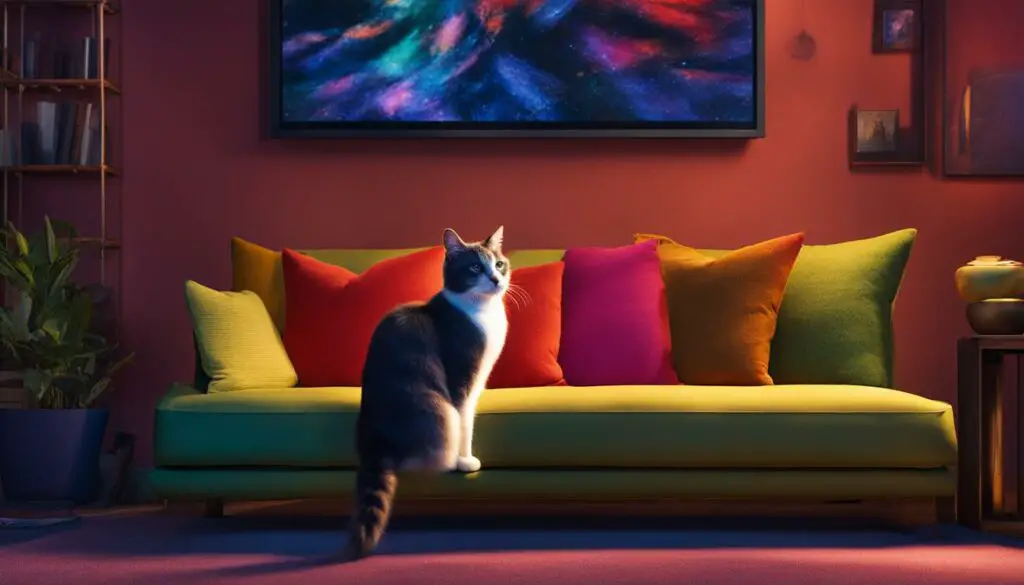
Allowing your cat to be a part of your TV viewing time can strengthen your bond with them. You can create a cozy spot nearby, such as a soft blanket or a cat bed, where your cat can relax while you watch television. This way, they can feel included and enjoy the company of their favorite humans.
It’s worth noting that not all cats will be interested in sitting in front of the TV, and that’s perfectly fine. Each cat has their own unique preferences and behaviors. As long as your cat is happy and healthy, there is no need to be concerned if they choose not to join you in front of the screen.
Environmental Enrichment
Understanding cat’s interest in TV and their behavior is essential to ensure their well-being. One way to address their fascination with the television is by providing environmental enrichment. This means creating an environment that offers a variety of stimulating activities and outlets for their natural instincts. By incorporating interactive toys, scratching posts, and puzzle feeders, you can provide mental and physical stimulation for your cat.
Additionally, offering vertical spaces such as cat trees or shelves allows cats to climb and observe their surroundings, mimicking their natural hunting behaviors. Creating hiding spots with cozy beds or blankets can provide comfort and a sense of security. These environmental enrichment techniques help prevent boredom and allow cats to engage in their natural behaviors.
| Benefits of Environmental Enrichment | How to Provide Environmental Enrichment |
|---|---|
| – Prevents boredom | – Use interactive toys |
| – Stimulates mental and physical activity | – Provide scratching posts |
| – Mimics natural hunting behaviors | – Incorporate puzzle feeders |
| – Creates a sense of security | – Offer vertical spaces |
By implementing these strategies, you can redirect your cat’s attention away from the TV and provide them with a stimulating environment that fulfills their natural instincts. Remember to observe your cat’s behavior and preferences to tailor the environmental enrichment to their specific needs. With a well-enriched environment, your cat will be happier, healthier, and less fixated on the television.
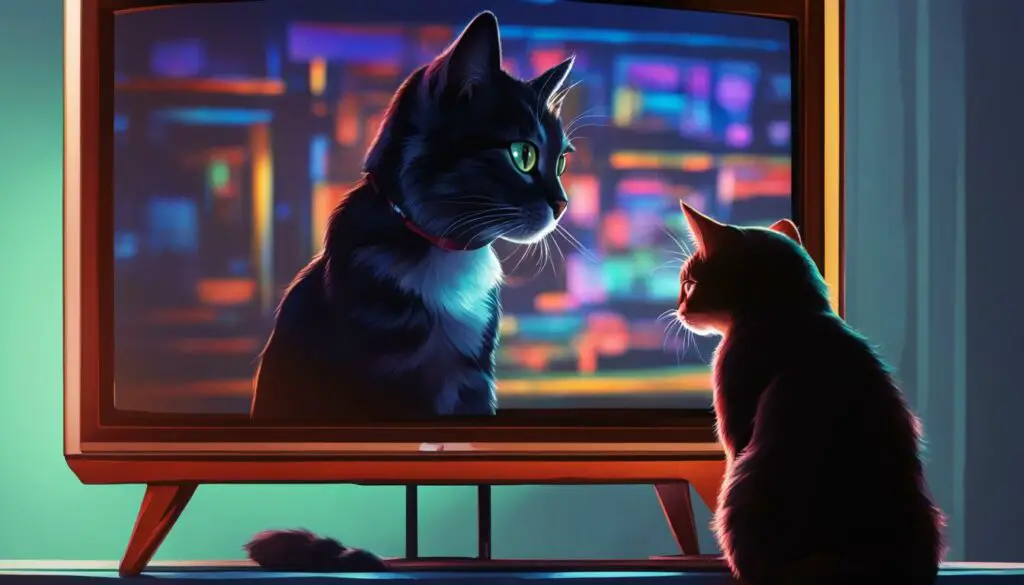
Addressing Undesirable Behavior
While sitting in front of the TV might be a normal behavior for cats, it can become problematic if it interferes with their daily routines or causes disruptions. If your cat’s TV fixation is excessive or starts to interfere with their eating, sleeping, or playtime, it may be necessary to redirect their attention.
One approach is to provide alternative sources of entertainment, such as interactive toys or a designated playtime with you. This allows them to engage in activities that fulfill their natural instincts and provide mental and physical stimulation. Additionally, creating a separate area with their own toys and scratching posts can help redirect their focus away from the TV.
Consistency is key in addressing undesirable behavior. By consistently redirecting their attention and providing alternative outlets for their energy, you can help break the habit of sitting in front of the TV. It may take time and patience, but with positive reinforcement and training, your cat can learn to engage in more appropriate behaviors.
Table: Alternative Strategies for Addressing Cat’s TV Fixation
| Strategy | Description |
|---|---|
| Providing Interactive Toys | Offer a variety of toys that mimic prey movement and engage your cat in play sessions to redirect their focus away from the TV. |
| Designating Playtime | Set aside dedicated playtime with your cat, using interactive toys and engaging in activities that provide mental and physical stimulation. |
| Creating a Separate Play Area | Designate a specific area where your cat can engage in play and exploration, equipped with toys, scratching posts, and other enrichment items. |
| Positive Reinforcement | Reward desirable behaviors, such as using their scratching post or playing with their toys, to encourage them to engage in alternative activities. |
By implementing these strategies and making the necessary adjustments to your cat’s environment, you can effectively address their fixation on the TV and encourage more appropriate behaviors. Remember, every cat is unique, so it may require some trial and error to find the approach that works best for your furry friend.
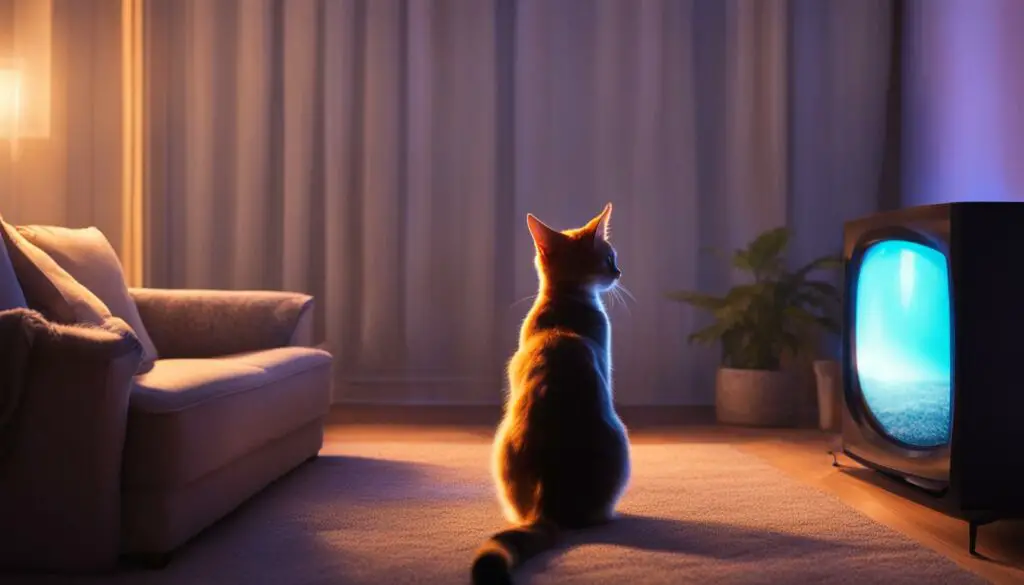
Seeking Veterinary Advice
Understanding your cat’s behavior around the TV is important, especially if it seems excessive or if it is accompanied by other changes in their behavior or health. If you have concerns, it is always a good idea to consult with your veterinarian. They can help rule out any underlying medical conditions that may be contributing to the behavior and provide guidance on how to address it.
Your veterinarian may recommend behavior modification techniques or suggest environmental changes that can help alleviate your cat’s fixation on the TV. They can assess your cat’s overall health and provide personalized recommendations based on their specific needs. Seeking veterinary advice is a proactive step in ensuring the well-being of your furry friend.
| Reasons to Seek Veterinary Advice for Your Cat’s TV Fixation |
|---|
| Your cat’s behavior around the TV is excessive and interferes with their daily routines. |
| The fixation on the TV is accompanied by changes in your cat’s overall behavior or health. |
| Your cat shows signs of distress or discomfort when unable to engage with the TV. |
| You want guidance on behavior modification techniques or environmental changes to redirect your cat’s attention. |
By seeking veterinary advice, you can gain valuable insights into your cat’s behavior and find appropriate solutions to address their fixation on the TV. Remember, every cat is unique, and a customized approach is essential in finding the best way to redirect their attention and provide them with a fulfilling and enriched environment.
Creating a Cat-Friendly Environment
When addressing your cat’s fixation on the TV, it is crucial to create a cat-friendly environment that meets their needs and provides alternative sources of entertainment. Here are some steps you can take:
1. Provide Vertical Space
Cats love to climb and observe their surroundings from high vantage points. Install cat trees or shelves in your home to give them plenty of vertical space. This not only fulfills their natural instinct to climb but also allows them to have a better view of the surroundings, offering mental stimulation and engagement.
2. Designated Play Areas
Set up specific play areas for your cat where they can enjoy interactive play sessions. Use toys that mimic prey and engage in playtime with them regularly. This provides mental and physical stimulation, redirecting their attention from the TV and satisfying their natural hunting instincts.
3. Interactive Toys and Puzzle Feeders
Provide a variety of interactive toys and puzzle feeders to keep your cat entertained. These toys offer mental stimulation and can keep them engaged for longer periods. Puzzle feeders also encourage natural foraging behavior, preventing boredom and undesirable behaviors.
4. Scratching Posts and Hiding Spots
Cats have a natural need to scratch and hide. Make sure you have scratching posts or boards readily available for them to fulfill their scratching instincts. Additionally, provide hiding spots such as cozy cat beds or boxes, where they can retreat to when they want some alone time or feel safer.
| Creating a Cat-Friendly Environment |
|---|
| Provide Vertical Space |
| Designated Play Areas |
| Interactive Toys and Puzzle Feeders |
| Scratching Posts and Hiding Spots |
By incorporating these strategies into your home, you can create a cat-friendly environment that addresses your cat’s needs and helps redirect their fixation on the TV. Remember that every cat is unique, so it may take some trial and error to find the right combination of elements that work best for your furry friend. With patience and consistency, you can provide a stimulating and enriching environment that keeps your cat happy and entertained.
Positive Reinforcement and Training
Understanding your cat’s interest in TV and decoding their behavior near the screen is key to addressing this common feline fascination. One effective approach is to use positive reinforcement and training techniques to redirect your cat’s attention away from the TV. By rewarding desirable behaviors and encouraging alternative activities, you can help break the habit of sitting in front of the screen.
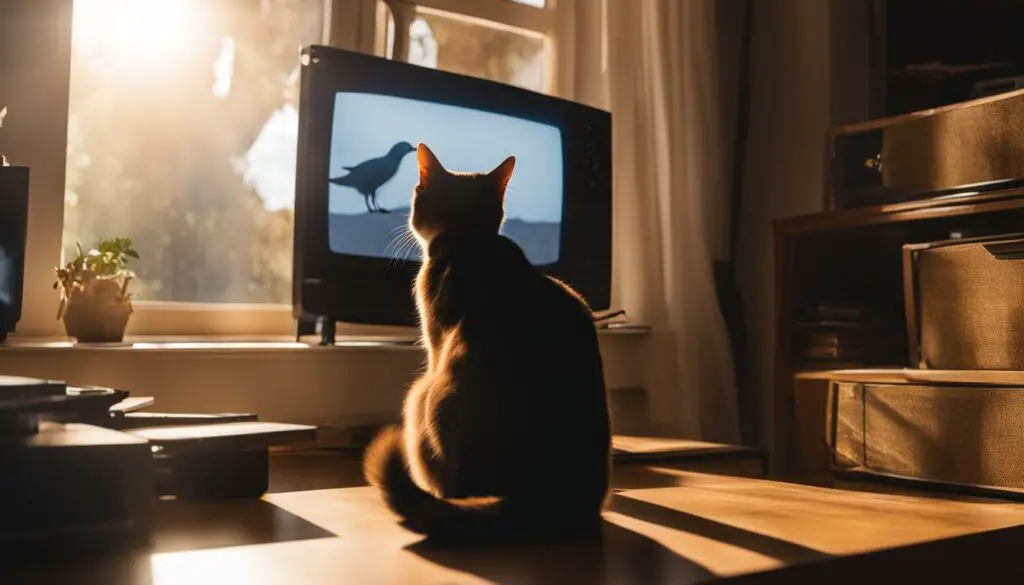
Start by engaging in interactive play sessions with your cat, using toys that mimic prey and encourage them to engage in natural hunting behaviors. Use treats, praise, and playtime as rewards to reinforce these behaviors and create a positive association with alternative activities. Consistency and patience are crucial in training your cat, as it may take time for them to change their habits.
Additionally, creating a designated play area with their own toys, scratching posts, and climbing structures can help redirect their focus away from the TV. Cats are active animals that need mental and physical stimulation, so providing plenty of enrichment options is essential. Puzzle toys and treat-dispensing devices can provide mental stimulation, while vertical spaces like cat trees or shelves offer opportunities for climbing and observing their surroundings.
Remember that each cat is unique, so it may take some experimentation to find the best approach for your furry friend. Be patient and adapt your training techniques to suit your cat’s personality and preferences. With positive reinforcement and training, you can help redirect your cat’s attention, satisfy their natural instincts, and create a harmonious environment for both of you.
Providing Alternative Entertainment
Cats have a natural curiosity and fascination with the world around them, and this includes television screens. While it may be amusing and entertaining to watch your cat engage with the TV, it’s important to provide alternative sources of entertainment to keep them mentally and physically stimulated. By offering a variety of activities and toys, you can redirect their attention and prevent them from solely focusing on the TV.
Interactive Toys: One effective way to provide alternative entertainment for your cat is by using interactive toys. These toys engage your cat’s natural hunting instincts and keep them mentally stimulated. Try toys that mimic prey, such as feather wands or laser pointers, to keep your cat engaged and active.
Puzzle Feeders: Another option is to use puzzle feeders. These toys require your cat to work for their food, stimulating their problem-solving skills and providing mental enrichment. There are a variety of puzzle feeders available on the market, ranging from simple treat-dispensing balls to more complex puzzle boards.
| Alternative Entertainment Options for Cats |
|---|
| Interactive Toys |
| Puzzle Feeders |
| Bird Watching Area |
| Interactive Play Sessions |
Bird Watching Area: Many cats are fascinated by birds and enjoy watching them. Creating a bird-watching area near a window can provide hours of entertainment for your cat. Place a bird feeder outside the window and position a cat tree or perch nearby to give your cat a comfortable vantage point.
Interactive Play Sessions: Spending dedicated playtime with your cat is essential for their overall well-being. Use toys that encourage them to chase, pounce, and jump. This not only provides physical exercise but also strengthens the bond between you and your feline friend.
Remember, every cat is unique, and it may take some trial and error to find the activities and toys that best capture your cat’s interest. By providing a wide range of alternative entertainment options, you can ensure that your cat has a fulfilling and enriching environment.
Managing Screen Time
Understanding your cat’s interest in TV and their tendency to sit in front of the television can help you create a balanced and engaging environment for your feline friend. While it may be entertaining to watch your cat interact with the TV, it’s important to manage their screen time appropriately to prevent overstimulation and potential behavior issues.
Limiting the amount of time your cat spends in front of the TV is crucial. Instead of relying on the TV for entertainment, engage with your cat using interactive toys, such as puzzle feeders or treat-dispensing devices, to provide mental and physical stimulation. These activities can redirect your cat’s attention and keep them engaged in a healthier and more interactive way.
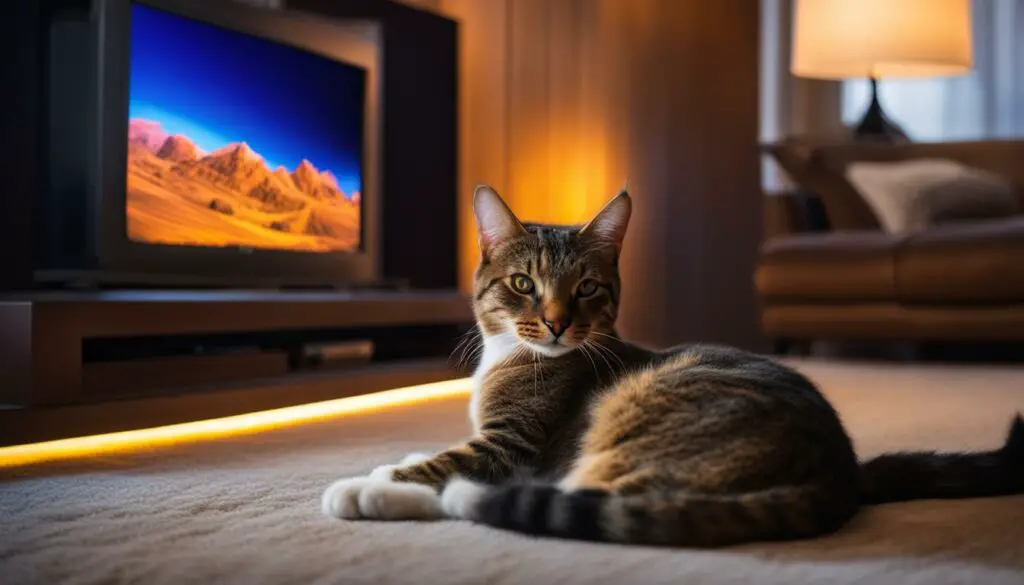
| Managing Screen Time Tips for Cats |
|---|
| Set boundaries and establish a schedule for TV time. Limit the amount of time your cat spends in front of the TV to prevent overstimulation. |
| Engage in interactive play sessions with your cat using a variety of toys. This will provide mental and physical stimulation while redirecting their attention from the TV. |
| Utilize puzzle feeders or treat-dispensing devices to keep your cat engaged and mentally stimulated during TV time. |
| Create a designated play area for your cat with toys, scratching posts, and hiding spots to encourage alternative forms of entertainment. |
| Consider providing a bird-watching area by placing a bird feeder outside the window. This can capture your cat’s interest and provide visual stimulation. |
Remember, managing your cat’s screen time is crucial for their overall well-being. By providing alternative sources of entertainment and engaging in interactive play, you can ensure that your cat remains mentally and physically stimulated while minimizing their fixation on the TV.
Conclusion
In conclusion, understanding why cats sit in front of the TV can help us address their needs and provide appropriate stimulation. While there is no one-size-fits-all answer, several factors contribute to their fascination with the television.
Cats may sit in front of the TV due to their prey instincts being triggered by the movement and sounds on the screen. The bright colors and flickering images can also attract them. Additionally, some cats may be seeking attention or finding comfort in the presence of the TV.
To redirect their attention, it is important to provide alternative sources of entertainment and create a cat-friendly environment. Engaging in interactive play sessions, offering interactive toys, and setting up a bird-watching area can help divert their focus from the TV. Additionally, positive reinforcement and training can be effective in discouraging fixation on the TV.
Remember, every cat is unique, so it may take time and experimentation to find the best approach. By understanding your cat’s behavior and addressing their needs, you can ensure a healthy balance of entertainment and enrichment for your furry friend.
FAQ
Why does my cat sit in front of the TV?
Cats may sit in front of the TV due to the movement, sounds, and bright colors on the screen that mimic prey and attract their attention. They may also be curious about the images and seeking attention from their human companions.
How can I redirect my cat’s attention from the TV?
You can redirect your cat’s attention from the TV by providing alternative sources of entertainment, such as interactive toys and designated playtime. Engaging in interactive play sessions and using positive reinforcement can also help redirect their focus.
What can I do if my cat sits in front of the TV when I’m not at home?
If your cat exhibits this behavior when you’re not at home, you can provide them with other sources of comfort, such as a cozy bed or blankets with your scent. Leaving on calming music or a TV show designed for cats can help alleviate their stress and provide a sense of security.
How can I satisfy my cat’s need for visual stimulation?
You can satisfy your cat’s need for visual stimulation by providing interactive toys, puzzle feeders, or setting up a bird feeder outside the window. These can offer alternative sources of visual entertainment for your cat.
Is it normal for cats to sit in front of the TV?
Yes, it is a normal behavior for cats to sit in front of the TV. It can be a form of environmental enrichment and a bonding experience between you and your cat. However, it is important to manage their screen time and provide other outlets for their energy.
What should I do if my cat’s fixation on the TV becomes excessive?
If your cat’s fixation on the TV becomes excessive and interferes with their daily routines or causes disruptions, you can redirect their attention by providing alternative sources of entertainment and engaging in interactive play sessions. Creating a separate area with their own toys and scratching posts can also help redirect their focus.
Should I be concerned if my cat sits in front of the TV often?
If you are concerned about your cat’s behavior around the TV or if it is accompanied by other changes in their behavior or health, it is always a good idea to consult with your veterinarian. They can rule out any underlying medical conditions and provide guidance on how to address it.
How can I create a cat-friendly environment to prevent TV fixation?
You can create a cat-friendly environment by providing plenty of vertical space, such as cat trees or shelves, and creating designated play areas with interactive toys. Incorporating scratching posts and hiding spots can also fulfill their natural instincts and prevent boredom.
How can positive reinforcement and training help redirect my cat’s attention?
Positive reinforcement and training can be effective tools in redirecting your cat’s attention from the TV. By rewarding desirable behaviors, such as playing with their toys or using their scratching post, you can reinforce those behaviors and discourage fixation on the TV.
What are some alternative entertainment options for my cat?
Alternative entertainment options for your cat include interactive toys, puzzle feeders, and treat-dispensing devices. Creating a bird-watching area by placing a bird feeder outside the window can also capture their interest.
How can I manage my cat’s screen time?
To manage your cat’s screen time, it is important to set boundaries and limit the amount of time they spend in front of the TV. Use interactive toys and play sessions as a way to engage with them and provide mental and physical stimulation.
Source Links
- https://cats.com/why-is-my-cat-staring-at-me
- https://www.purina.co.uk/articles/cats/behaviour/understanding-cats/why-do-cats-stare
- https://www.splootvets.com/post/understanding-your-cats-body-language

